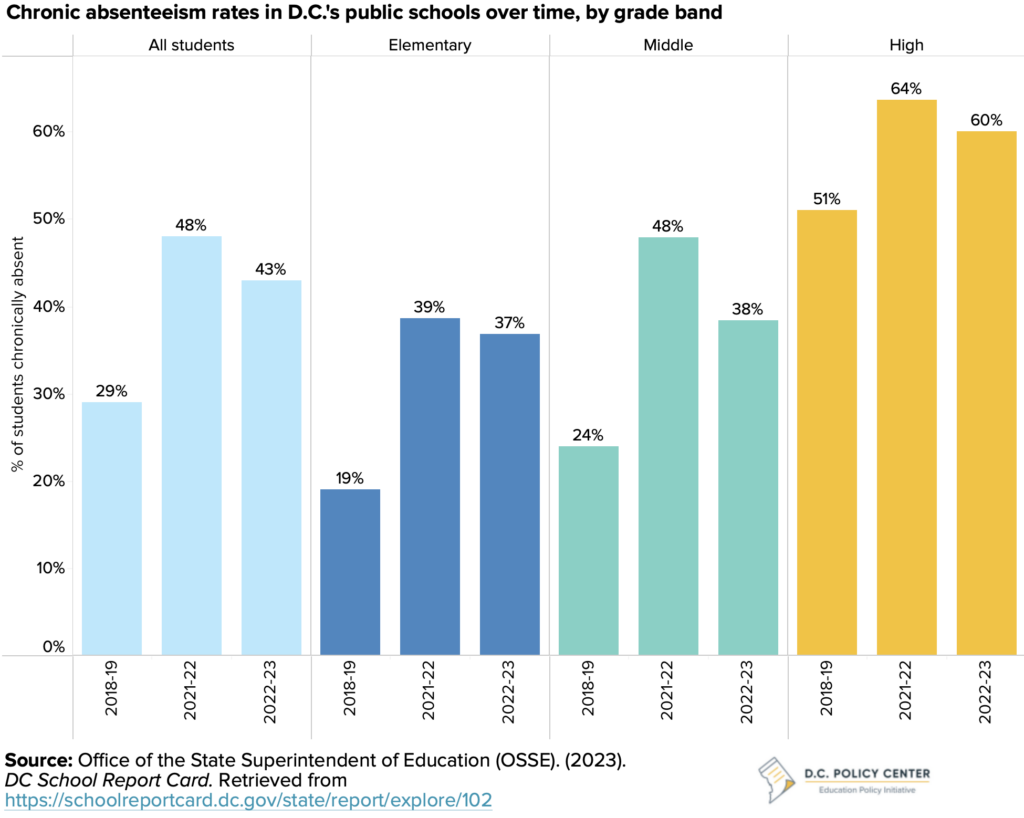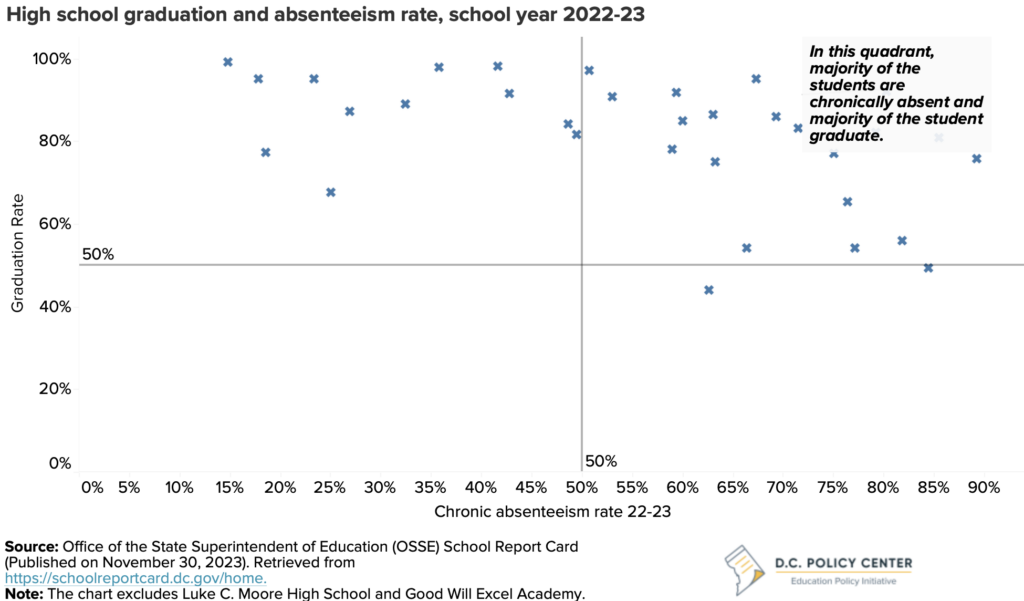

On December 12th, 2023, Senior Education Research Analyst at the Education Policy Initiative, Hannah Mason, testified before the D.C. Council Committee of the Whole, at its public hearing on chronic absenteeism and chronic truancy in the District. Her testimony focuses on trends in chronic absenteeism across grade bands focusing specifically on high school grades. You can read her testimony below, or download a PDF copy.
: Chronic absenteeism is still higher than pre-pandemic, especially in high school gradesChronic absenteeism declined slightly in school year 2022-23, but is still at historically high levels.
Chronic absenteeism remains one of the greatest challenges for D.C.’s public school system, especially at the high school level. D.C.’s school report card data for school year 2022-23 shows that chronic absenteeism declined to 43.7 percent, a 4.4 percentage point decrease from 48.1 percent in school year 2021-22.1 However, in school year 2018-19, 29.4 percent of students were chronically absent2, so this is still 14 percentage points higher than pre-pandemic.
Chronic absenteeism has decreased in each grade band, especially in middle school grades. Yet, in high school, a majority of students are still chronically absent at 60 percent. In high school, almost a third of 9th graders start high school with “profound” chronic absenteeism, with 31 percent of 9th graders missing 30 percent or more of school days.3 This is extremely concerning because research has shown that 9th grade is a pivotal year for students, often determining on time graduation, academic success, and more.4


Reasons for students being absent are shifting post-pandemic.
The D.C. Policy Center conducted listening sessions last June to understand students’, teachers’, and parents’ experiences in the 2022-23 school year. In our sessions, we learned multiple new reasons that could be behind this peak of higher absenteeism rates compared to pre-pandemic. Participants reported taking more mental health days as a reason for missing school especially contributed to an uptick in violence. Unsurprisingly, illness was seen as a more common reason. Lastly, students attending school for shorter days and leaving early was more common during this school year.
There are new perceptions impacting absenteeism.
In our listening sessions, we also learned of new perceptions students and families have regarding in-person school which is impacting absenteeism. As students get older, the importance of in-person school seems less necessary for students and parents. With virtual options to make up work being made available, attending school in person doesn’t appear as paramount. There’s also less perceived accountability for attending school, and some parents believe that the attendance records for their students aren’t accurate.
Another post-pandemic change, the new attendance policy, is more flexible, but it could be masking the true extent of absenteeism.
The new attendance policy implemented in school year 2022-23 states that students must attend at least 60 percent of the day, meaning they can miss up to 40 percent of the day without being counted as absent (compared to 20 percent under the old policy). This makes it impossible to compare pre-and-post pandemic absenteeism rates. While this policy is more flexible for students and families, it creates the wrong incentive for attendance, allowing students to place a lower importance on coming to school.
In addition, chronic absenteeism does not seem to impede high school graduation.
While there is a statistically significant negative correlation between absenteeism and graduation rates, there are high schools where the majority of students are chronically absent, and a majority graduate. This means students may be less incentivized to attend school on a regular basis if they’re still able to graduate.


It is extremely important to reduce chronic absenteeism because it undermines all other investments the District makes in public education. The OSSE attendance report finds that for both math and English Language Arts (ELA), students who were chronically absent demonstrated below median growth.5
When students are not present, they do not learn, they cannot benefit from high impact tutoring, they cannot access mental health supports, career services, and a slew of other investments the District has made in the public school system, including investments that support recovery-oriented programs. Realigning incentives to attend school would be one way to move forward.
Endnotes
- Office of the State Superintendent of Education (OSSE). (2023, November 30). DC School Report Card – Attendance. Retrieved from https://schoolreportcard.dc.gov/state/report/explore/102
- Office of the State Superintendent of Education (OSSE). 2022. DC School Report Card Data. Retrieved from https://osse.dc.gov/dcschoolreportcard
- Office of the State Superintendent of Education (OSSE). (2023, November 30). District of Columbia – Attendance Report 2022-23 School Year. Retrieved from https://osse.dc.gov/sites/default/files/dc/sites/osse/publication/attachments/2022-23%20Attendance%20Report_FINAL_0.pdf
- Easton, J, Johnson, E, & Sartain, L. (2017, September). The Predictive Power of Ninth Grade GPA. Retrieved from https://consortium.uchicago.edu/sites/default/files/2018-10/Predictive%20Power%20of%20Ninth-Grade-Sept%202017-Consortium.pdf
- Office of the State Superintendent of Education (OSSE). (2023, November 30). District of Columbia Attendance Report –2022-23 School Year. Retrieved from https://osse.dc.gov/sites/default/files/dc/sites/osse/publication/attachments/2022-23%20Attendance%20Report_FINAL_0.pdf
